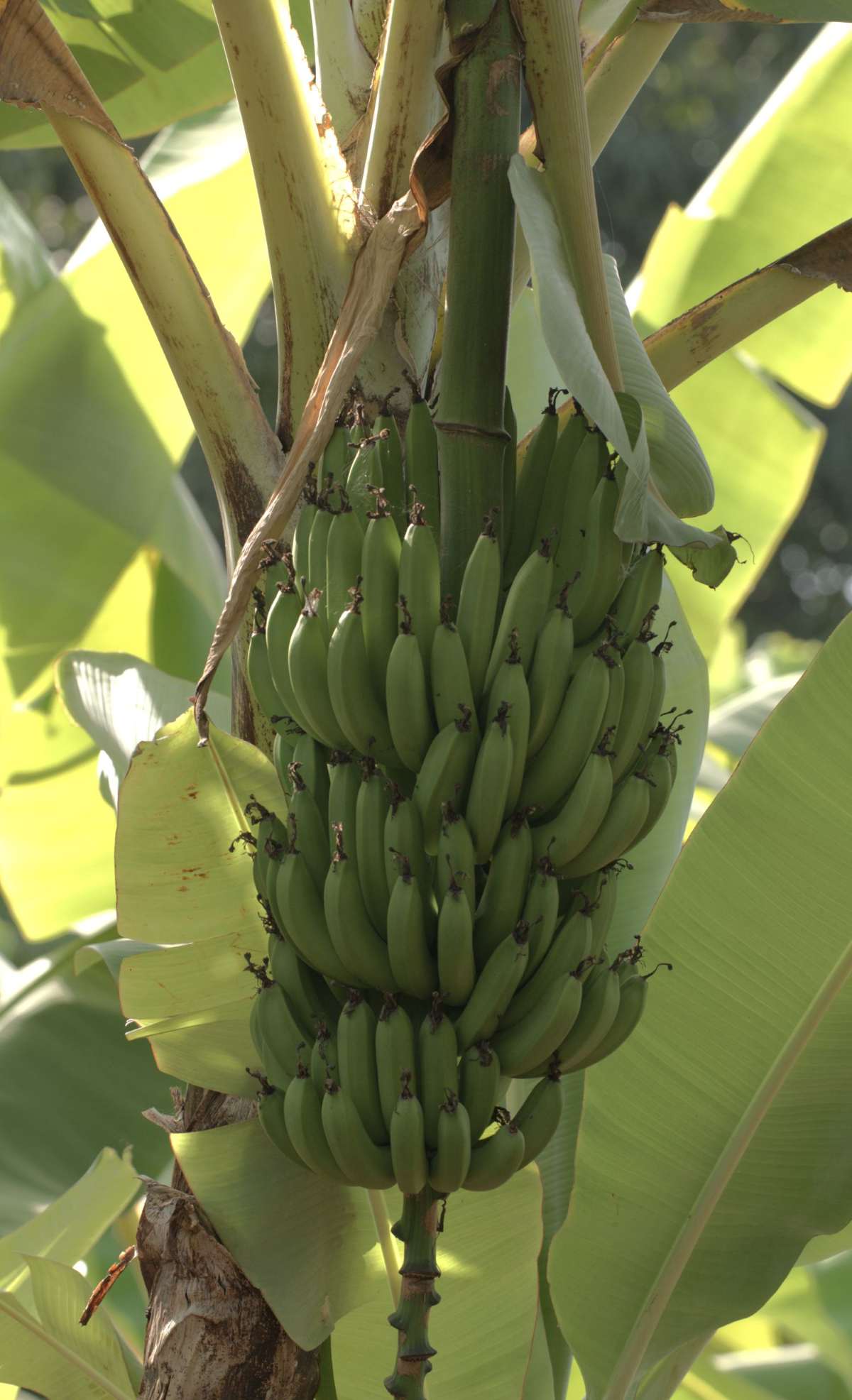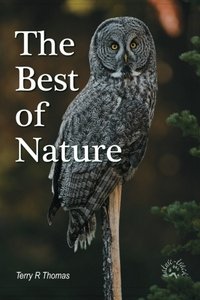Going Bananas

Very young bananas growing in a bunch in Tanzania. When the bunch is harvested, the pseudo-stem dies and a new one takes its place.
We were in the Tanzanian village of Mto Wa Btu, trying to find a new bird or two to add to our list. Our guide, Fred, stopped alongside a small planting of perhaps an eighth of an acre. “These are banana trees.” he declared in his wonderfully accented English (Fred speaks four languages). We were amazed as he described the biology of this plant with the fruit known worldwide. None of us had any idea that bananas grow as they do.
Bananas are the world’s most popular fruit, with over 100 billion consumed annually. That is an average of 13 bananas a year for every human on the planet. Most of us eat far more than that. It ranks as the fourth most vital staple food worldwide. The world’s biggest producers of bananas are India, China, Brazil, Ecuador, and the Philippines. Although India is the biggest producer by a wide margin, they consume most of their production domestically leaving Ecuador as the biggest exporter. Indomalaya and Australia are the ancestral home of the banana and Southeast Asia remains the center for banana diversity (they were probably domesticated in New Guinea), but Africa, where we stood, was second in diversity of banana types, having been in the banana “business” since 600 A.D. Today, most tropical countries produce bananas which account for 75 percent of the tropical fruit market, partly because bananas are non-seasonal, available fresh year-round.
It is the biology of the banana that is fascinating though. When Fred referred to it as a banana tree, he misspoke in that the banana is the world’s largest flowering herbaceous plant, not a tree. Each season a pseudo-stem, tree-iike in size and appearance but composed of multiple leaf stalks, not wood, grows from a corm, a bulb-like structure similar to that of the gladiolus and iris flowers. Each year, the pseudo-stem grows and produces one inflorescence, also known as the "banana heart". The flowers form on the outside of the heart in overlapping tiers called hands, of which there are usually 9-12, with up to 20 fruits per hand. Once the downturned flowers are pollinated and the ovary starts to swell, the developing fruit begins to turn upward, so the banana bunches have the flower end pointing upward as the fruit grows.
The growth of the pseudo-stem, leaves, and fruits is nothing short of phenomenal. The fastest growing varieties can grow over five feet per DAY. Depending on the variety, they take six months to a year to mature to a height of 12-24 feet. Fred told us that the ones we were looking at would mature at ten months. At that point, the fruit is ripe and the pseudo-stem dies. But that is not the end of the plant. Prior to that point, a small stalk from the bottom of the plant will already be growing from the corm, ready to replace the maturing pseudo-stem. In this sense, the banana plant is a perennial.
On commercial farms there are long rows of bananas in a monoculture. On family farms in East Africa, a single garden is likely to have several different species growing together. With as many as 3,000 different cultivars of bananas, small family farms find it advantageous to have multiple varieties.
Many years ago when I lived in the Central American paradise known as El Salvador, I remember sitting down to my first meal and staring at what looked like a cooked banana on my plate. I poked it with my fork and took a tentative bite. I wasn’t impressed, but after two years of eating them nearly every day, I came to appreciate the cooking banana or as they are sometimes called, the plantain. Plantains are bananas too, but have less sugar and more starch. They are a very important food source in much of the world, and like “dessert” bananas, come in many different cultivars.
Fred made one last point about bananas before we got back to birding. The banana fruit is botanically a berry, “a fleshy fruit without a drupe (pit) produced from a single flower containing one ovary. Berries so defined include grapes, currants, and tomatoes, as well as cucumbers, eggplants, persimmons and bananas, but exclude certain fruits that meet the culinary definition of berries, such as strawberries and raspberries (Wikipedia).”
I love bananas in so many ways. When I can wrestle a few Hi-Chews from the grandkids, I always hunt for the yellow “banana-flavored” ones first. Bananas are perfect on ice cream and breakfast cereal, add flavor to oatmeal and smoothies, and are even great sliced and dried. Bananas make an awesome nutritious snack, are wonderful in gelatine and fruit salads, and some varieties of plantains make a good substitute for potatoes. We should be grateful that bananas found a place on this planet.

Help Idaho Wildlife
When we traveled across the state in October 2017, we visited most of the Idaho Department of Fish and Game wildlife management areas. Most of the vehicles we saw using the wildlife management areas did not have wildlife plates. Buying wildlife plates is a great way for non-hunters and hunters alike to support wildlife-based recreation like birding.
C'mon folks, let's help Idaho's wildlife by proudly buying and displaying a wildlife license plate on each of our vehicles!
See below for information on Idaho plates. Most states have wildlife plates so if you live outside Idaho, check with your state's wildlife department or vehicle licensing division for availability of state wildlife plates where you live.
And tell them that you heard about it from Nature-track.com!
Wildlife License Plates
Great news! as of 2024, there are three NEW designs for license plates. They still are bluebird, cutthroat trout and elk, but they are beautiful.
Idaho Wildlife license plates provide essential funding that benefits the great diversity of native plants and wildlife that are not hunted, fished or trapped—over 10,000 species or 98% of Idaho’s species diversity. Game species that share the same habitats (such as elk, deer, antelope, sage-grouse, salmon, trout) also benefit from these specialty plates.
No state tax dollars are provided for wildlife diversity, conservation education and recreation programs. Neither are any revenues from the sale of hunting or fishing licenses spent on nongame species. Instead, these species depend on direct donations, federal grants, fundraising initiatives—and the Idaho Wildlife license plates.
Both my vehicles have Bluebird Plates. I prefer the bluebird because the nongame program gets 70 percent of the money from bluebird plates, but only 60 percent of the money from elk and trout plates - 10 percent of the money from elk plates supports wildlife disease monitoring and testing programs (to benefit the livestock industry) and 10 percent from cutthroat plates supports non-motorized boat access.
Incidentally, in 2014, the Idaho Legislature denied the Department of Fish and Game the ability to add new plates or even to change the name of the elk and cutthroat plates (very specific) to wildlife and fish plates, a move that would have allowed for changing images occasionally and generating more revenue. It would seem that they believe that we Idahoans don't want a well funded wildlife program.
I think it is time we let the Legislature know that Idahoan support wildlife funding and that we would like to see these generic plates come to fruition.

"WOW. What a phenomenal piece you wrote. You are amazing." Jennifer Jackson
That is embarrassing, but actually a fairly typical response to my nature essays. Since The Best of Nature is created from the very best of 16 years of these nature essays published weekly in the Idaho Falls Post Register (online readership 70,000), it is a fine read. It covers a wide variety of topics including humorous glimpses of nature, philosophy, natural history, and conservation. Readers praise the style, breadth of subject matter and my ability to communicate complex and emotional topics in a relaxed and understandable manner.
Everyone can find something to love in this book. From teenagers to octogenarians, from the coffee shop to the school room, these nature essays are widely read and enjoyed.
Some of the essays here are my personal favorites, others seemed to strike a chord with readers. Most have an important message or lesson that will resonate with you. They are written with a goal to simultaneously entertain and educate about the wonderful workings of nature. Some will make you laugh out loud and others will bring a tear to the eye and warm your heart.
Readers Write:
"You hit a home run with your article on, Big Questions in Nature. It should be required reading for everyone who has lost touch with nature...great job!" Joe Chapman
"We enjoyed your column, Bloom Where Planted. Some of the best writing yet. The Post Register is fortunate to have your weekly columns." Lou Griffin.
To read more and to order a copy, click here or get the Kindle version
Copies are also available at:
Post Register
Island Park Builders Supply (upstairs)
Barnes and Noble in Idaho Falls
Harriman State Park, Island Park
Museum of Idaho
Valley Books, Jackson Wyoming
Avocet Corner Bookstore, Bear River National Wildlife Refuge, Brigham City, Utah
Craters of the Moon National Monument Bookstore, Arco, Idaho